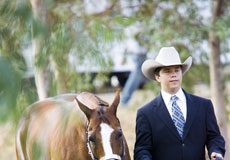If you’d like to truly “show off” your horse at a horse show, you can’t do much better than to enter him in a halter class. This ground-based class might appear a bit like showmanship at first, but unlike that class, halter judging is all about the horse. While the handler’s role is still to make his horse look as good as possible, the handler’s performance isn’t judged the same way it is in showmanship.

Many halter classes can be broken into two phases. One is the inspection phase, in which the judge examines one horse at a time and analyzes conformation and type while checking for any disqualifications. Each horse is also judged at the walk and trot in order for the judge to evaluate movement and way of going. The second phase involves returning to the “line up,” where each horse and handler wait while the other competitors are inspected.

Different horse shows and classes will have different pattern requirements for halter classes. Some might want you to walk in for inspection and then trot away, some might require that all competitors come in trotting and then line up along the rail before inspection. Read and understand any posted patterns, watch any classes that are before yours, and listen carefully to instructions from the ringmaster or announcer.
Learn the specifics on how to show your breed or type. Some breeds, like Arabians, for instance, are shown in breed-specific tack and are positioned in a special way when standing in the ring. Some breeds are expected to be groomed differently than others (braiding, etc…) Find out what’s typical for your horse’s breed. Also, find out what you are expected to wear—it too can vary from breed to breed.

Like all horse show classes, grooming is important, but it is particularly important for halter. While the judge isn’t necessarily “judging” your horse’s grooming, if all things are equal and two horses are both excellent examples, the one with the better grooming job just might edge out the other. Give yourself enough time before the class to bathe, groom, polish hooves, braid, or whatever is required.
Remember, you and your horse are being judged during the entire halter class! Don’t stop showing just because you’re in the lineup of a very large class and other horses are being inspected.
Do you enjoy showing your horse in halter classes? Do you at compete at breed shows, or open shows? Let us know in the comments below.
This article about showing horses in halter classes originally appeared in Horse Illustrated magazine. Click here to subscribe!






Checking this out for my first halter class.
How do I find halter classes in New Jersey? My daughter has a 2-year-old Mustang she won’t be able to saddle train for at least another year or more.